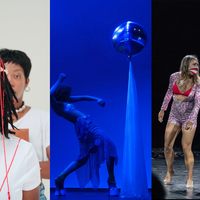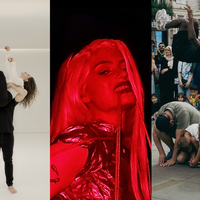Tue 14 Jan: Chevon Edwards, The Vril Project and Ophey Chan

News Story
Chevon Edwards offers a fresh take on the resurgence of far-right politics in Tyranny of the King Edwards. Though absurd, the solo reveals a fresh analysis of current events, scapegoating the spud as a representation of marginalised minority groups. Part Orwellian dystopia, part Chaplin slapstick, Edwards appears as a magician brandishing a red tablecloth between virtuosic duets with a potato, umbrella and a sinister-looking peeler. Whilst less assured performers might not carry off the bizarre nature of the work, Edwards is magnetic throughout. From her entrance, wailing in melodic despair as she heaves herself across the front of the stage, to the climax of the piece where she brutalises her tuber companion with a potato masher, Edwards is a committed and promising creator-performer… with a particular aptitude for eyebrow-ography.
Perhaps one of the most ambitious works of the night, The Parallel Gap is a multimedia exploration of how the personal and political overlap. A glossy white sheet takes centre stage, with undulating bodies trapped underneath as choreographer and principal dancer Ophey Chan writhes on top, her body meeting the others in a liminal exchange of thinly separated touch. Later, the sheet lifts towards the rig, bowing and breathing like an animated paper lantern. Whilst Chan’s introspective odyssey feels well-intentioned, with footage of pro-Palestine and climate-conscious protests projected on the cyclorama, the impact of the work is lost in its ambiguity. The questions Chan asks, conceptually and literally as she breaks the fourth wall, are somewhat nebulous, and the emotional reaction that the work promises feels a little beige—coincidentally the colour palette of the piece.
Battle Royale meets dance-marathon in Roulette, a frenetic display of embodied mania and violence. After setting the scene with unnerving reality TV confessionals, The Vril Project showcase the immense talent of the performers through detailed choreography. Each player displays a distinct individuality amongst group chaos, drawing on Krump, Breaking and physical theatre. Despite shifting dynamics within the group as alliances are built and broken, the stakes of the work remain somewhat one-dimensional, and the roulette motif of the game is lost amidst impressive physicality and self-strangulation. Aesthetically, the technicolour spots and vibrant washes of light feel dated. Perhaps this is intentional, evoking a sleazy casino-nightclub setting? Roulette concludes the night with an entertaining, albeit sadistic, crowd-pleasing display of high-energy dance theatre.
- Gian Sanghera-Warren
At Resolution, expecting the unexpected—like a duet with a potato—is de rigueur. In Tyranny of the King Edwards, Chevon Edwards animates her spud castmate with one hand, responding to its twists and tilts with exaggerated nods and pantomimic gestures. It doesn’t take long for their relationship to sour. “Don’t be a slave to starch!” “Potatoes cannot love you!” shouts a pithy voiceover. Evidently influenced by the anti-potato propaganda, Edwards—a master of physical comedy—descends into a slapstick frenzy, furiously decimating her vegetable friend with a masher, tripping clumsily while plugging in a microwave to deliver the final death sentence. When she goes to eat her enemy, she spits it out in disgust. Apparently, revenge doesn’t taste as sweet as she thought. It’s funny yet thought-provoking, the ridiculousness of the situation offering a sharp commentary on dehumanisation and the seduction of scapegoating. An absurdist Animal Farm for the 21st Century.
Ophey Chan also strives to make a bold socio-political statement in The Parallel Gap, yet struggles to pinpoint exactly what she wants to say. Opening with projections of the River Thames and chugging trains, the work flits between ideas without giving them enough time to develop. Multiple bodies writhe under a large sheet that is subsequently hoisted to float magically above them, a dancer coils her body around another in a close contact duet, and protest footage appears on the back wall as a voiceover delivers vague statements. “We all have dreams that light the way forward.” “Together we fight.” What are we fighting for? While well intentioned and performed with heart, The Parallel Gap ultimately falters due to a lack of specificity.
It’s all about the dancers in The Vril Project’sRoulette. To a dirty techno beat, seven talented performers chuck their arms, undulate their torsos, and hunch their shoulders in phrases reminiscent of renowned choreographer Hofesh Schechter’s signature style. There’s also incessant episodes of senseless violence as the cast repeatedly kick and strangle one another. This high-octane aggression persists throughout, showcasing the dancers' commitment and stamina, yet leaving little room for emotional variation. Roulette’s initial inspirations are somewhat lost in the process, the opening Big Brother style video interviews with the characters about gambling addiction a distant memory by the time the chaos reaches its peak.


